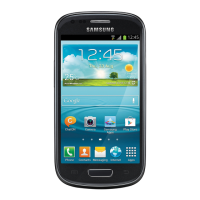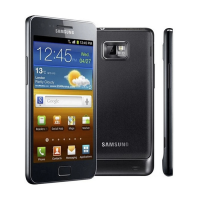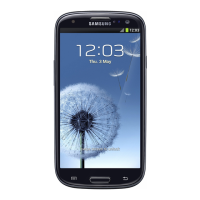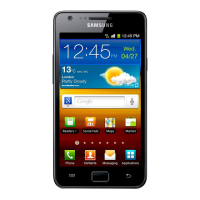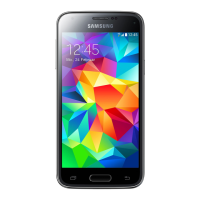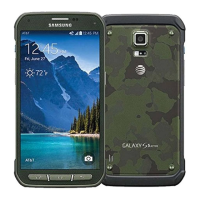Do you have a question about the Samsung Galaxy S III and is the answer not in the manual?
Explains manual structure, navigation, and text conventions.
Explains conventions used in the manual for step-by-step instructions.
Instructions and cautions for removing and replacing the battery cover.
Step-by-step guide for installing a microSD memory card.
Instructions for safely removing the microSD memory card.
Important information before installing or replacing the battery.
Step-by-step guide for installing the device battery.
Instructions for safely removing the device battery.
Guide on how to charge the device's Li-ion battery using the included charger.
Explains how the device indicates low battery status and behavior.
Tips and advice to conserve battery power and prolong usage time.
Steps for the initial setup process, including language and activation.
Instructions for turning the device on, off, or restarting it.
Steps to restart the device, which can resolve minor issues.
Information on how to lock and unlock the device screen for security.
Guide to creating a Google account for accessing device features.
Instructions on how to sign in to an existing Google account.
Steps to recover a forgotten Google account password.
Instructions on how to set the default storage location for media files.
Guide to creating a Samsung account for accessing specific applications.
Instructions on how to set up and access voicemail services.
How to access voicemail from the device itself.
Instructions for accessing voicemail from a different phone.
Explanation of the Task Manager for managing running applications.
How to close or end running applications to free up resources.
Information on Google Now, its functionality, and initial setup.
Highlights key features like the touch screen, data speeds, and screen size.
Identifies and explains the main elements on the front of the device.
Identifies and explains the external elements on the back of the device.
Identifies and explains the elements on the sides of the device.
Explains the device's display and its interface for managing features.
How to change settings related to wallpaper, brightness, and backlight.
Explains the information and icons displayed in the status bar.
Identifies and explains the various symbols displayed on the device screen.
Explains how the notification area indicates new message events and other statuses.
Instructions on how to clear notifications from the notification panel.
Provides quick access to various device functions via the notification screen.
Identifies and explains the use of the Home, Menu, and Back function keys.
Explains the Home screen as the starting point for applications and customization.
Options available when accessing the Home screen menu.
Overview of the Application menu for quick access to frequently used applications.
Explains how to navigate the device using the touch screen and keys.
How to access a list of recently used applications on the device.
Explains how to activate and use various gesture features for time-saving functions.
Instructions on how to calibrate the device using its built-in gyroscope.
Explains how to run multiple applications simultaneously on the screen.
How to move the Multi window tab and relocate the apps panel.
Example of launching and using multiple applications simultaneously.
How to customize Home screens with widgets, shortcuts, folders, and wallpapers.
How to find and display your phone number in the device settings.
Instructions on how to make a phone call using the keypad.
How to keep a call active while using other device features.
Instructions on how to end an active phone call.
Guide on how to make emergency calls, with or without a SIM card.
Explains options available on the keypad screen, like Voicemail and Call.
How to answer or reject an incoming call, including messaging options.
How to categorize callers as rejected contacts and manage the rejection list.
Instructions for making international calls, including country codes.
How to dial or save phone numbers with pauses for automated systems.
How the phone waits for a dial tone before proceeding with numbers.
How to recall numbers from dialed, received, or missed calls.
How to set up and use speed dial entries for quick dialing.
Guide to using the voice recognition application for various device functions.
Features available during an active phone call, such as volume and speakerphone.
How to adjust earpiece and incoming call volume during a call.
How to turn mute on or off during a phone call.
Instructions for switching audio output to a Bluetooth headset during a call.
Options for viewing contacts, creating messages, or memos during a call.
How to adjust noise reduction to improve conversation quality.
How to adjust the sound equalizer for the current call.
Information on making multi-party or conference calls.
How to answer an incoming call while already on a call.
Accessing a list of placed, accepted, and missed calls for redialing.
Overview of call log entries and available options like creating contacts or sending messages.
How to delete individual or all call log entries.
How to view missed call information directly from the lock screen.
Describes available text input methods: Google voice typing, Samsung keyboard, and Swype.
How to enable and configure the Swype text input method.
How to choose between ABC and SYM modes within Swype text entry.
How to enter text using Swype in 123ABC mode.
How to enter numbers and symbols using Swype in SYM mode.
Guide to configuring settings for the Samsung keyboard.
Explains how to use voice typing, handwriting, and clipboard for text input.
How to switch between ABC and Symbol/Numeric modes in the Samsung keyboard.
How to use voice recognition to enter text on the device.
How to set up, manage, and synchronize accounts for applications.
Default storage location for saving phone numbers and managing contacts.
Guide to creating new contact entries and assigning them to various accounts.
Methods for locating contacts stored on SIM card, phone memory, or external locations.
Steps to edit existing contact details and save changes.
How to add a new phone number to an existing contact entry.
How to add pauses or waits to existing contact phone numbers.
Important information and steps for deleting contacts from the device.
Various options for managing the contacts list, including delete, import/export, and merge.
Options available when touching and holding a contact entry for context menu access.
Options specific to a contact entry's overview screen.
How to merge multiple entries for the same contact into a single record.
How to separate merged contact entries back into individual records.
How to set a default contact entry for applications like Voice Dialer.
How to send contact information as a Virtual Business Card via Bluetooth, Email, or message.
How to send all contact entries at once via various methods.
Steps to send a namecard to a recipient using Bluetooth.
Procedure to copy contact information from phone memory to a SIM card.
How to sync contact data from online or remote accounts to the phone.
How to choose which contacts to display and filter them by phone number.
How to add contacts by synchronizing applications like Facebook, Twitter, or Google.
How to send an email to a contact from the device.
How to set default storage, display phone number, and view service numbers.
Allows adding new or existing contacts to call groups like Family, Friends, or Work.
Steps to create a new caller group with custom name and ringtone.
How to add existing contacts to a caller group.
How to remove contacts from a caller group.
How to modify the name, ringtone, or members of a caller group.
How to send a text message to a selected group of contacts.
Accessing a list of phone numbers designated as favorite contacts.
Describes the different message types available: Text, Multimedia, Email, Hangouts, etc.
Step-by-step guide for composing and sending text or multimedia messages.
Options available before and while composing a message, like search and delete threads.
How to open the notification bar and select a message to read its contents.
How sent and received messages are grouped into threads for easier conversation tracking.
Options for managing message threads, like viewing contacts or deleting threads.
Options for managing individual message bubbles within a conversation.
Instructions for deleting single or multiple message threads and bubbles.
How to search through messages using keywords.
How to configure settings for text, multimedia, voice mail, and push messages.
How to use and create text message reply templates for quick responses.
How to review and create emails using various services like Gmail and Microsoft Exchange.
Step-by-step guide to setting up an internet email account on the device.
How to open and view email messages on the device.
How to refresh the email screen to check for new messages.
Instructions for composing and sending an email, including attachments and recipients.
How to alter settings for accounts, signatures, and notifications.
How to access company email servers for synchronizing email, contacts, and calendar.
Guide to setting up a Microsoft Exchange email account on the device.
How to open and view exchange email messages.
How to refresh exchange email to check for new messages.
Information on composing exchange emails, referring to a general guide.
How to delete an exchange email message.
How to configure settings for Microsoft Exchange email accounts.
How to sign into and use Google Mail (Gmail) for email services.
How to open and view Gmail messages.
How to refresh Gmail mail for new messages.
Additional options for managing Gmail messages like labels and search.
Instructions for composing and sending a Gmail message.
How to add another Gmail account to the device.
An updated place for instant messaging, photo sharing, and video calls offered by Google.
Features of Google+ for messaging, sharing, and uploading photos/videos.
How Messenger facilitates group conversations and receives Google+ updates.
How to set the default storage location for camera and camcorder features.
Guide to taking photographs using the device's built-in camera.
Explains the various icons and shortcuts available for camera functions.
How to add a name tag to a photo using contact information.
Options available when viewing a picture, such as favorites, share, and delete.
Options available when viewing a video, such as selecting, playing, or additional options.
Explains features for instantly sharing pictures as they are taken or quickly sharing a single picture.
How to enable Wi-Fi Direct communication and pair devices for group sharing.
How to beam large files like videos and pictures directly to another compatible device via NFC.
How to share multiple pictures using the S Beam feature.
How to access and manage stored camera images within the Gallery.
How to capture the current screen display using gesture controls.
How to set an image as a contact photo for an entry.
How to set an image as wallpaper for the Home screen, Lock screen, or both.
Guide to recording, viewing, and sending high definition videos.
Instructions on how to shoot video using the device's camcorder.
How to view videos saved in the Camera folder or play them from the Gallery.
Where to view photos, play videos, perform editing, and set wallpapers or caller images.
How to access the Gallery application from the Home screen.
How to locate and play a video file from within the Gallery.
How to play video files stored on the SD card, including DivX videos.
How to share videos via Bluetooth, Email, Google+, Messaging, etc.
Feature allowing video playback in the background while multitasking.
Information about DivX video playback capabilities and requirements.
How to find the VOD registration code within the device settings.
Steps for one-time registration to play purchased DivX movies on the device.
Connect to Play Store, download, and stream movies and TV shows instantly.
Browse, shop, and play songs purchased from Play Store, stored in Google Music library.
Application to play music files and navigate music library.
How to search for songs, albums, or playlists within the music library.
How to adjust preferences for the music player application.
Instructions on how to play songs from the music library.
How to return to the Now Playing screen from other music screens.
Various options available from tabs like Playlists, Artists, Albums, Songs, Genres.
Various options and controls available while a song is playing.
Steps to create a new playlist for organizing music files.
How to add songs to an existing or new playlist.
How to select and begin playback of a playlist.
How to delete a created playlist.
How to make online music available for offline playback on the device.
Explains the Music Player application and its controls.
Preferences for the music player, including background playback and sound effects.
Quick access to all available applications on the phone.
How to use the device as a basic or scientific calculator.
How to consult the calendar, create events, and set alarms.
Steps to create a new calendar event.
How to select the start day, view options, and manage event reminders.
Using the 8.0 megapixel camera for photos and HD video recording.
How to use the Google Chrome Web browser on the device.
Features like setting alarms, world clock, stopwatch, and timer.
Detailed steps for setting and configuring alarms.
How to activate an on-screen clock for when the device is docked.
Default storage location for saving phone numbers to the Contacts List.
Quick access to lists of current downloaded files from the internet and other sources.
How to review and create email messages, and receive alerts for important emails.
Where to view photos, play videos, perform editing, and set wallpapers or caller images.
Using Gmail as a web-based email service, automatically synchronized with the Google account.
How to use Google Search to find information on the web.
Configure preferences for Google+ features, Maps, Latitude, Location, and Search.
Features of Google+ for messaging, sharing, and uploading photos/videos.
Lets you share documents, photos, or music in real-time with connected friends.
An updated place for instant messaging, photo sharing, and video calls offered by Google.
Provides access to built-in help information for device navigation.
How to use the browser to navigate the mobile web and enhance browsing features.
Displays company logos on Google Maps, allowing quick location of businesses and information.
Track current location, view traffic, and get destination directions using Google Maps.
How to enable wireless networks or GPS satellites for Google Maps functionality.
Allows using SMS and MMS services to send and receive text and multimedia messages.
Facilitates group conversations and receives Google+ updates.
Application to play music files and create playlists.
Provides access to current account information for downloading applications.
Manage sounds, images, videos, Bluetooth files, and other memory card data.
Internet-connected turn-by-turn GPS navigation system with voice guidance.
How to enable GPS satellites and wireless networks for location services.
Options for configuring the navigation application, including travel method and destination input.
Features available on the map screen, like destination search, layers, and map views.
Make or answer calls, access contacts list for storing contact information.
Read ebooks on the go, build library in the cloud, and personalize the reader.
Subscribe to favorite magazines and read them on the device anytime, anywhere.
Connect to Play Store, download, and watch movies instantly.
Browse, shop, and play songs purchased from Play Store.
Access downloadable applications and games, provide feedback, and flag incompatible apps.
How to download new applications using a Google account and the Play Store.
How to launch applications that are already installed on the device.
Allows installation of non-Play Store applications for Android development.
Manage installed applications, view memory usage, and clear data/cache.
How to clear the cache or data for specific applications.
How to uninstall applications downloaded from the Play Store.
View and control currently running services like Backup, Hangouts, SNS, and Swype.
Create memos using keypad, finger, or both, adding images and voice recordings.
Steps to create a new memo in text or drawing mode.
Launches voice recognition system for initiating tasks like call, text, navigate, and play music.
Application for wireless synchronization and streaming content to TVs.
Wirelessly mirror device screen content to an external TV via AllShare Cast Hub.
How to set up parameters for Samsung Link, like Wi-Fi, storage, and optimization.
How to use web storage services to store and share files on the cloud.
How to share media files from the device to a target device using Samsung Link.
Hardware to mirror device screen content directly onto an external TV.
How to connect the AllShare Cast Hub hardware to a power source and TV.
Steps to activate the AllShare Cast feature on the device.
Guide for pairing the device with the AllShare Cast Hub for the first time.
Information on the video sharing website and how to view videos.
How to access the main Settings menu on the device.
Describes Wi-Fi settings, including activation, connection, and advanced options.
How to turn on the device's Wi-Fi feature to discover and connect to networks.
Steps to connect the device to a detected Wi-Fi network.
Icons that indicate the Wi-Fi connection status: connected, active, or direct communication.
How to manually add a new Wi-Fi network connection by entering SSID and security.
How to turn off the Wi-Fi feature from Settings or the Notification bar.
How to manually initiate a scan for available Wi-Fi networks.
Advanced Wi-Fi settings including sleep policy, MAC address, and IP configuration.
How to activate or deactivate notifications for available Wi-Fi networks.
Configures whether Wi-Fi connection stays active during device sleep mode.
How to check for Wi-Fi Internet access after connecting to a Wireless Access Point.
How to find the device's MAC Address and IP Address.
How to manually add a Wi-Fi network by entering SSID and security details.
Pair device and WAP using WPS button without entering passcode.
Steps to pair the device with a wireless access point using WPS.
Alternative WPS method using a device-generated PIN to establish connection.
Steps to pair device using WPS PIN entry method.
Configure device to connect directly with other Wi-Fi capable devices for data transfer.
Steps to activate the Wi-Fi Direct connection on the device.
Activate Bluetooth, set device name, manage visibility, and scan for devices to pair.
Instructions for turning Bluetooth on and off using the Settings menu.
How to verify Bluetooth is active and rename the device.
How to make the device visible for other Bluetooth devices to pair and communicate.
How to scan for active Bluetooth devices to pair with.
Monitor and manage data usage, including activation/deactivation and setting data limits.
How to activate or deactivate mobile data usage on the device.
How to set warning and maximum data limits and adjust the data usage cycle.
Displays additional wireless and network information.
How to use device features like Camera and Games in airplane mode.
Enabling Mobile network options for location-based applications like Google Maps.
Allows activation of mobile data usage on your device.
How to set up and manage Virtual Private Networks (VPNs) on the device.
Determine VPN protocol and configure settings for adding a VPN.
Steps to connect to an existing VPN entry on the device.
How to edit the settings for an existing VPN connection.
How to remove a VPN connection record from the device.
Feature to read and exchange tags, used with Android Beam for content transfer.
Beam large files like videos and pictures directly to another device via NFC.
Share media files with nearby devices using DLNA and Wi-Fi Direct.
Wirelessly mirror device screen content to an external TV via AllShare Cast Hub.
How to connect the device to a computer wirelessly using Kies Air.
Access and configure general call settings like restriction, ringtones, and call alerts.
Configure general call settings using options like call restriction and ringtones.
Manage rejection mode, list, and set auto-reject options for incoming calls.
Manage existing rejection messages or create new ones for rejected calls.
Manage device ringtone, vibration, incoming call alerts, and keypad tones.
Assign call alert tones and activate call alerts and vibration.
Manage settings for answering and ending calls, including answering key and voice commands.
Turns on proximity sensor during calls to save power by turning off the screen.
Assign headset settings for incoming calls, including automatic answering.
Personalize sounds heard during calls with and without earphones.
Adds an extra volume button on the screen during active calls.
Increases ringtone volume when device is in a pocket or bag.
Configure additional call settings, including noise reduction.
View voicemail number and settings.
Assign a default ringtone for incoming voicemail messages.
Activate vibration for incoming voicemail messages.
Use default or user-defined prefixes for international dialing.
Configure TTY settings for communication with deaf or hard-of-hearing individuals.
Set the length of time tones are heard when tapping numbers on the dialpad.
Reduces incoming caller voice sound for enhanced privacy.
Set display layout to Standard mode or an easier user experience Starter mode.
Control sounds and configure display settings for the phone.
How to mute the speaker and use vibration for notifications in Silent Mode.
Access various volume settings for music, ringtone, notifications, and system.
Select the intensity of vibration for incoming calls, notifications, and haptic feedback.
Set the ringtone for incoming calls and voicemail messages.
Set the device to vibrate and ring for notifications and alarms.
Set the ringtone for notifications and alarms.
Adjust the sound and vibration functions of the device.
Options for tones when using dialing pad, screen selection, lock screen, or touch screen.
Change settings for display such as font, orientation, brightness, and screen timeout.
Configure screen display settings like wallpaper, LED indicator, and multi window.
Allows context-related pages to be created on the Home screen.
Adjusts the on-screen brightness level.
Automatically switches screen orientation between portrait and landscape.
Adjusts delay time before the screen automatically turns off.
Disables auto screen rotation by checking face and device orientation.
Disables screen timeout if the device detects your face is watching the screen.
Sets the fonts used on the LCD display.
Allows selection of font size for display.
Adjusts the light duration of the touch keys.
Activates/deactivates the display of battery charge percentage on the screen.
Adjusts LCD brightness to automatically conserve battery power.
Configures the LCD Brightness levels.
Sets the Wallpaper for your Home screen, Lock screen, or both.
Turns on/off LED lights for charging, low battery, and notifications.
View memory allocation and manage SD card mounting/unmounting.
How to view memory allocation for the external SD card.
How to mount the SD card to store applications and establish USB connection.
How to unmount the SD card to prevent corruption and damage.
How to erase files from the SD card using the device.
Automatically sets power saving mode and configures options to conserve battery.
View components using battery power and their percentage usage.
Manage installed applications, view running services, and clear data/cache.
How to clear the cache or data for specific applications.
How to uninstall applications downloaded from the Play Store.
View and control currently running services like Backup, Hangouts, SNS, and Swype.
View a list of current applications sorted by size.
Configure the device's location services.
Enable wireless networks for location services like Google Maps.
How to enable GPS satellites for location services.
How to enable GPS satellite for Location and Google Search.
Configure device security parameters like unlock patterns and PINs.
Secure data by requiring an unlock pattern each time the device is turned on or wakes up.
Unlock the device by swiping the screen.
Lock or unlock the device by tilting it forwards or backwards.
Steps to unlock the device using motion gestures.
Unlock phone using facial recognition.
Unlock phone using facial recognition and voice command.
Increase phone security by drawing an unlock pattern.
Change or update the previously stored unlock pattern.
How to remove the screen lock pattern and set it to None.
How to unlock the device using PIN or Google Account credentials if pattern is forgotten.
Steps to unlock the device using a PIN code.
How to unlock the device using Google account credentials.
How to set up and use a PIN for locking and unlocking the phone.
How to set up and use a password for locking and unlocking the phone.
Activate or deactivate various unlock screen functions like shortcuts and clocks.
How to use and edit application shortcuts on the lock screen.
Displays the on-screen lock grid when the Make pattern visible option is enabled.
Define time before device automatically locks.
Automatically locks the screen after pressing the Power/Lock key.
Feel vibration feedback while drawing patterns or using PIN/password locks.
Show user-defined information on the Lock screen.
Determine the security level for the device.
Requires PIN/password to decrypt phone or encrypt SD card data.
Configure phone password display and settings.
Allows Google to administer the phone similar to IT security settings.
Enable installation of non-Play Store applications.
Allows applications to access secure certificates and credentials.
Configure language for menus and set on-screen keyboard options.
Set the display language and region for menus on the phone.
Select an input method from settings or notification screen.
Configure Swype settings like vibrate on keypress, sound, trace, and auto-correction.
Configure Google voice typing settings, including language and offensive word blocking.
Allows device to correctly recognize verbal input for voice search.
Provides verbal readout of on-screen data using TTS engines.
Configure pointer speed for a connected mouse or trackpad.
Manage location settings, backup configurations, or reset the phone.
Configure device to back up current settings, applications, and data.
Reset device and sound settings to factory defaults.
Set up, manage, and synchronize accounts including Google and email.
Steps to add an account type and enter credentials.
Important: Removing an account deletes its messages, contacts, and data.
Manually sync all managed accounts or sync specific accounts.
Assign specific functions to device actions detected by accelerometer and gyroscope.
How to activate motion features in the Settings menu.
Activate desired on-screen motion options like Direct Call and Smart Alert.
Capture on-screen information by swiping across the screen with your hand.
Pause video or mute sound by covering the screen with your hand.
Provides on-screen descriptions for motion functionality.
Adjust sensitivity settings for currently active gestures like Gyroscope calibration.
Information about RF energy exposure from wireless phones and potential health effects.
Discusses findings from studies on the link between RF exposure and health issues.
Details on a study monitoring health issues linked to long-term cell phone exposure.
Information on a study investigating the relationship between RF exposure and brain cancer in young people.
Information on cancer statistics and the role of cell phones in brain cancer risk.
Steps urged by the FDA for the cell phone industry regarding RF exposure.
Steps to minimize RF exposure, including using hands-free devices.
Information about hands-free kits like Bluetooth headsets and body-worn accessories.
Discusses accessories claiming to reduce RF absorption, with a note on their effectiveness.
Discusses RF exposure risks for children and steps to reduce exposure.
Explains SAR limits set by the FCC and how they are determined.
User warnings and conditions regarding FCC rules, interference, and operation.
How the device receives wireless emergency alerts via CMAS.
Advice and warnings for responsible driving and using mobile devices safely.
Instructions on how to make an emergency call, ensuring connection and providing information.
Suggestions for keeping the mobile device clean and preventing damage from liquids or environmental factors.
Precautions against exposing the device to dust, dirt, or sand.
Guidance on cleaning the mobile device using mild solutions.
Warning against dropping or shaking the device to prevent internal damage.
Warning against painting the mobile device as it can affect operation.
Cautionary advice to avoid potential hearing loss from loud sounds and prolonged exposure.
Reminders to follow regulations and switch off the device in certain areas.
Advice on potential interference between mobile devices and other electronic equipment.
Safety precautions for users with implantable medical devices like pacemakers.
Information about how location data is used and shared by applications.
How AGPS technology assists emergency responders in locating the user.
Information about potential inaccuracies in map data and confirming instructions.
Instructions on what to do if the device gets wet.
Explains FCC requirements for wireless device compatibility with hearing aids.
Warnings about children playing with the device and keeping it out of reach.
FCC notices regarding potential TV/radio interference and cautions about device modifications.
Safety advice regarding servicing, vehicle installation, headsets, and aircraft usage.
Legal agreement for the use of preloaded software on the device.
| Panel type | AMOLED |
|---|---|
| Display diagonal | 4.8 \ |
| Display resolution | 1280 x 720 pixels |
| Display number of colors | 16.78 million colors |
| Volume control | Digital |
| Networking standards | IEEE 802.11a, IEEE 802.11b, IEEE 802.11g, IEEE 802.11n |
| Processor frequency | 1.4 GHz |
| RAM capacity | 2 GB |
| Compatible memory cards | MicroSD (TransFlash) |
| Maximum memory card size | 64 GB |
| Internal storage capacity | 16 GB |
| Flash type | LED |
| Photo effects | Black&White, Negative film, Pastel, Sepia, Solarisation |
| White balance | Auto, Cloudy, Daylight, Fluorescent, Incandescent |
| Front camera type | Single camera |
| Rear camera resolution (numeric) | 8 MP |
| Front camera resolution (numeric) | 1.9 MP |
| 2G standards | EDGE, GPRS |
| 3G standards | HSDPA, HSUPA |
| Data network | 3G |
| SIM card type | MiniSIM |
| Wi-Fi standards | 802.11a, 802.11b, 802.11g |
| Bluetooth version | 4.0 |
| Bluetooth profiles | A2DP, AVRCP |
| SIM card capability | - |
| 2G bands (primary SIM) | 850, 900, 1800, 1900 MHz |
| Audio formats supported | AAC, eAAC+, FLAC, MIDI, MP3, OGG, WAV, WMA |
| Video formats supported | AVI, DIVX, H.263, H.264, MPEG4, WMV, XVID |
| USB version | 2.0 |
| HDMI ports quantity | 0 |
| Headphone connectivity | 3.5 mm |
| USB 2.0 ports quantity | 1 |
| Form factor | Bar |
| Product color | White |
| Multimedia Messaging Service (MMS) | Multimedia Messaging Service (MMS) is a standard way to send messages that include multimedia content to and from a mobile phone over a cellular network |
| Platform | Android |
| App distribution platform | Google Play |
| Operating system installed | Android 4.1.1 |
| Talk time (2G) | 16 h |
| Talk time (3G) | 11 h |
| Battery capacity | 2100 mAh |
| Standby time (2G) | 580 h |
| Standby time (3G) | 510 h |
| Sustainability certificates | RoHS |
| Depth | 8.6 mm |
|---|---|
| Width | 70.6 mm |
| Height | 136.6 mm |
| Weight | 131 g |

